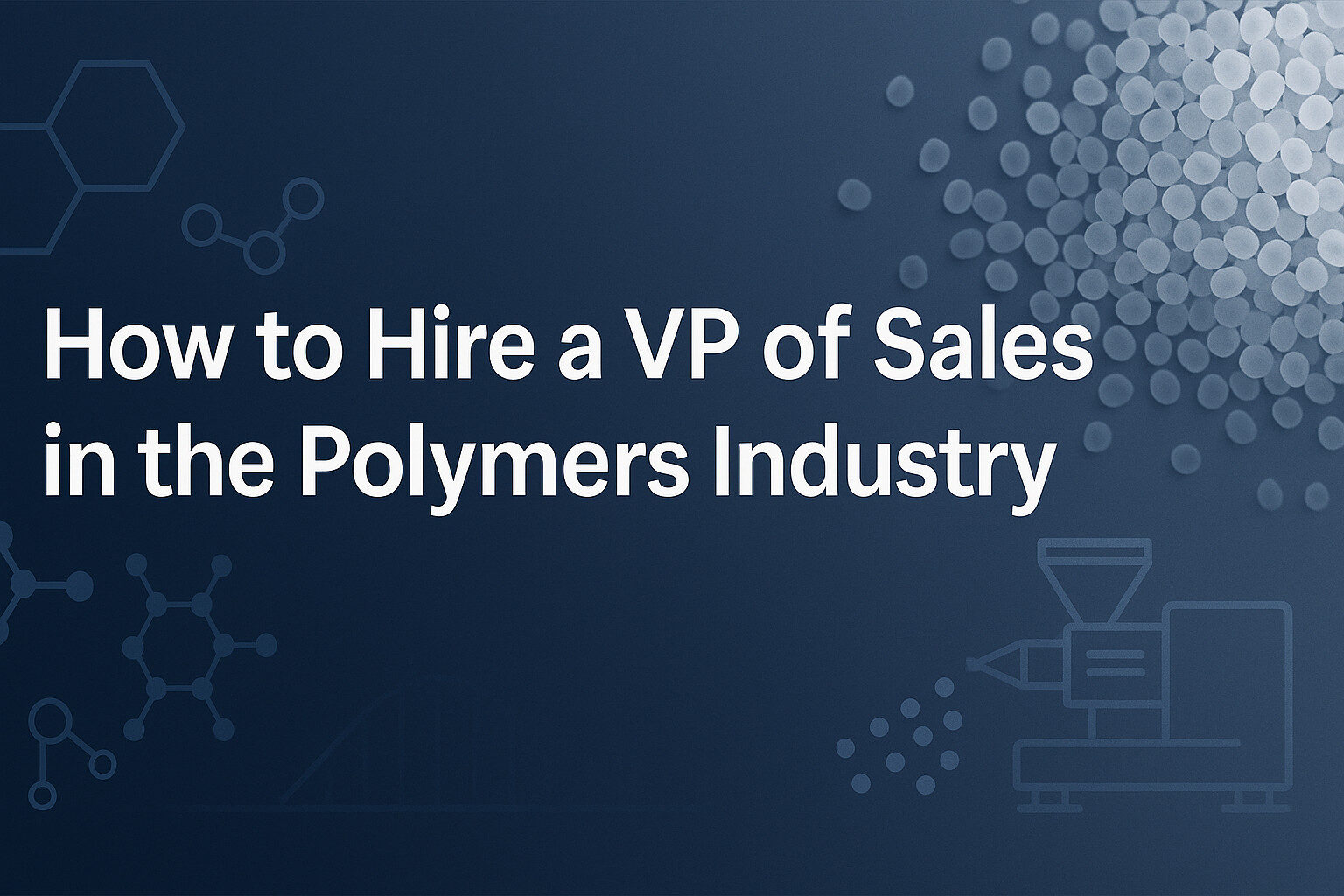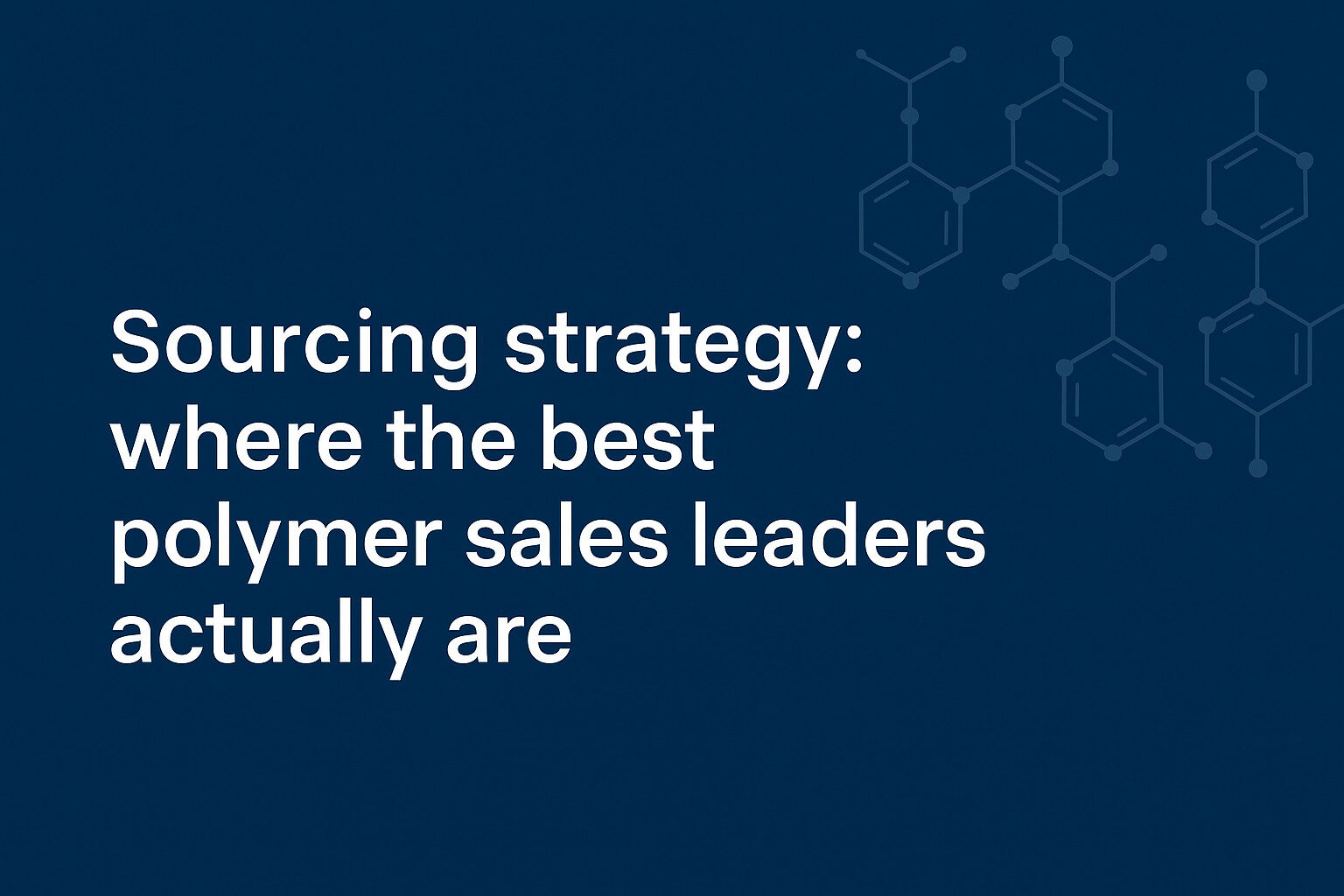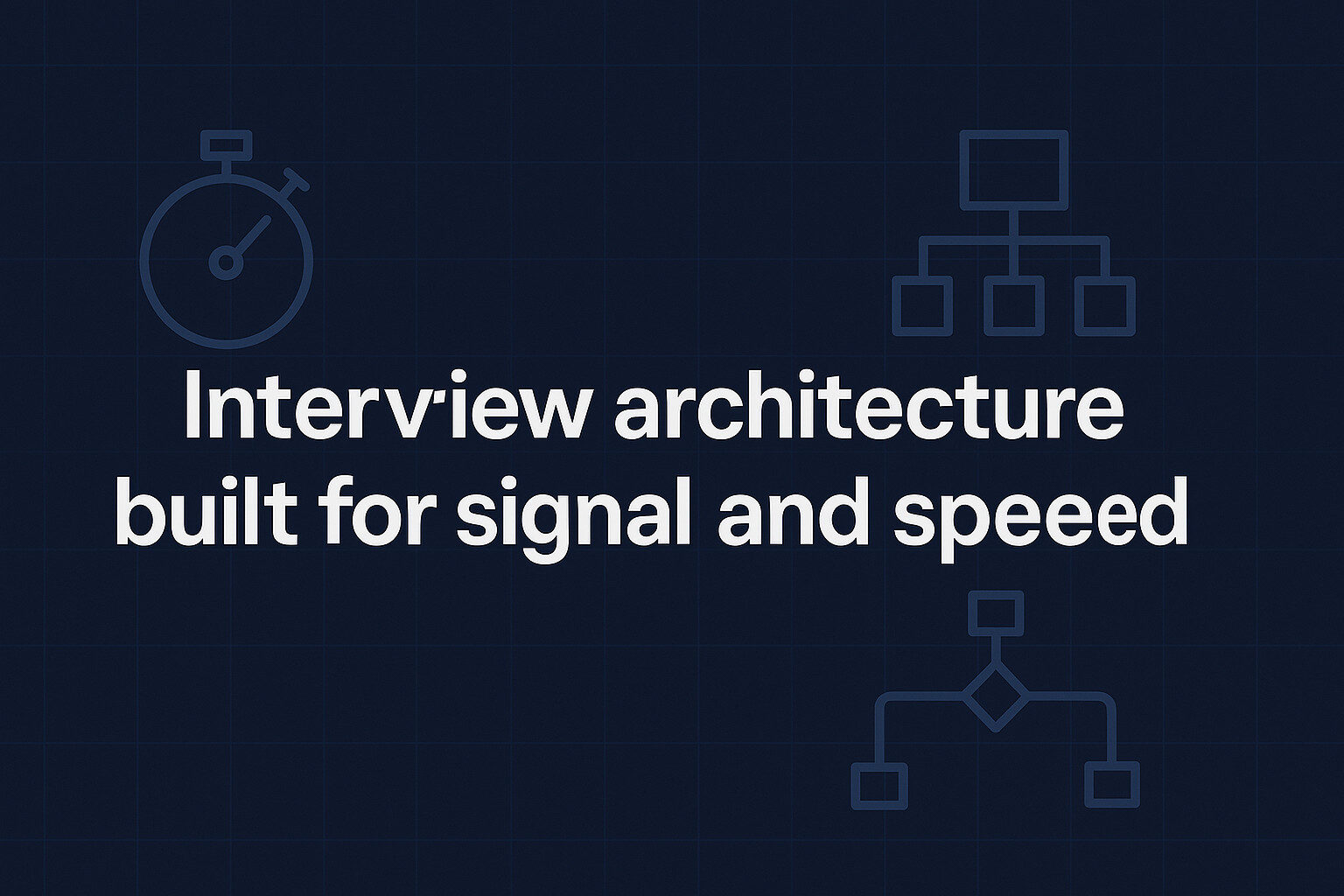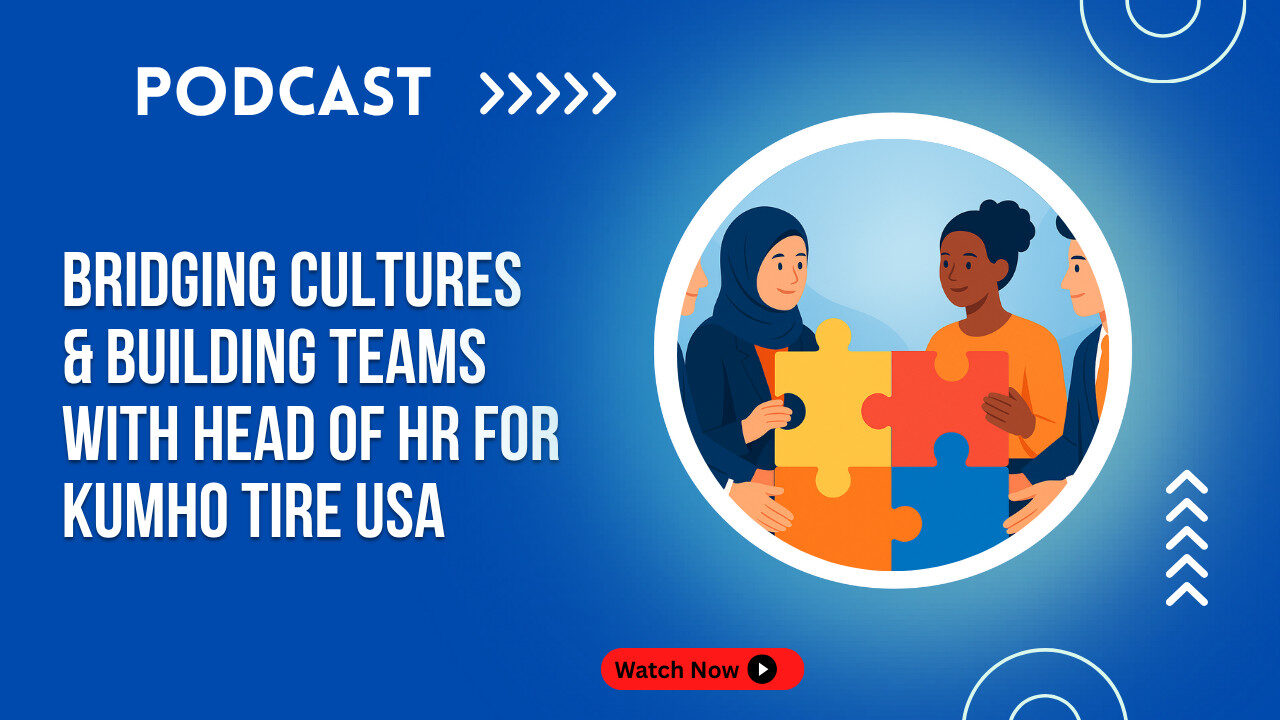If you’re planning to hire a VP of Sales in the polymers industry, you’re filling one of the most important roles in manufacturing. Polymers touch everything—mobility, medical, packaging, energy, building materials—and the right sales leader can defend price and mix during resin volatility, build durable distributor ecosystems, and move your margin profile from “good” to “top quartile.” This guide is a 360° playbook: what outcomes to hire for, where to source leaders, how to assess for real-world performance, how to structure compensation, and exactly what to do in the first 90 days to create momentum.

Why This Role Is Uniquely Tough (and High Impact)
The polymers market isn’t generic industrial. Your VP must navigate:
- Resin volatility: Ethylene/propylene swings, surcharges, and energy costs.
- Application depth: Automotive, medical, packaging, electronics, and industrial each with distinct regulatory and performance needs.
- Channel complexity: Direct OEM, Tier suppliers, converters, distributors, and rep firms—often all in the same territory.
- Quality & compliance: ISO/IATF, FDA/USP Class VI, UL/CSA, RoHS/REACH, sustainability claims (PCR, bio-based, mass balance).
- Pricing pressure: Customers benchmark alternatives constantly; price architecture and value defense matter as much as prospecting.
Bottom line: Your best candidates blend technical curiosity (polymers & applications), commercial discipline (price/mix, forecast accuracy, channel rules), and leadership (building managers and distributor partners who execute consistently).
Define the Role by Outcomes, Not Tasks
Great searches begin with clarity. Replace generic bullet lists with three to four measurable outcomes. Examples:
- Price & mix defense: Hold or improve gross margin by 1.5–3.0% while growing strategic SKUs.
- Pipeline quality: Lift stage-weighted pipeline coverage to 3–4× quarterly bookings; maintain ≥70% forecast accuracy.
- Channel health: Increase distributor sell-through, stock turns, and training certifications; align MDF to ROI.
- Team performance: Grow and energize the current sales team to hit 90%+ attainment on target earnings.
Everything else—org design, territories, playbooks—should reinforce these outcomes.
Competency Model (Non-Negotiables)
Use this as your scorecard backbone. Hire the strengths you can’t teach fast.
Technical & Market Fluency
- Polymer families & applications: Polyolefins, styrenics, engineering resins, elastomers, thermosets, additives, masterbatch.
- Standards: UL/CSA, USP Class VI, ISO 10993, REACH/RoHS, food contact.
- Processing: Injection, extrusion, blow molding, thermoforming, compounding; how spec choices hit cost/performance.
Commercial Discipline
- Price architecture, discount governance, freight/surcharge logic.
- Territory design, quota setting, and forecast hygiene.
- Enterprise deal strategy (MEDDIC/BANT or similar), multi-threaded selling.
- Key-account planning and renewal defense.
Channel Leadership
- Distributor selection, onboarding, training, and QBRs.
- MDF planning, spiff programs, and conflict resolution (direct vs. channel).
- Sell-through programs that drive turns, not just sell-in.
Team Leadership
- Hiring and ramping RSMs/KAMs; clear territories; coaching cadence.
- Enablement: Playbooks, competitive battlecards, ROI tools.
- Cross-functional influence with R&D, applications, quality, and operations.
Compensation Architecture That Closes (Without Overpaying)
Compensation varies by company size, segment, and location, but use this structure to move decisively:
- Base salary (typical U.S. mid-market manufacturer): $185k–$360k.
- Variable/OTE: $120k–$220k tied to profitable bookings; accelerators for price hold, mix gains, and strategic SKUs.
- Long-term incentives: RSUs/phantom equity with 3–4-year vest; align to EBITDA, working capital, and growth milestones.
- Sign-on/retention: To offset forfeited awards; milestone-based retention for launches/consolidations.
- Benefits: Car allowance, relocation, and executive development budget.
Publish your base + OTE philosophy in the brief. Transparency shortens cycles and improves acceptance rates.

Sourcing Strategy: Where the Best Polymer Sales Leaders Actually Are
1) Adjacent-Market Mapping (Highest Yield)
- Resins & compounds: OEM resin producers, compounders, masterbatch/colorants.
- Additives & chemicals: Stabilizers, UV absorbers, flame retardants, coupling agents.
- Processing/automation: Injection & extrusion machinery, hot runners, robotics—leaders who already sell into your buyers.
- Converters & Tier suppliers: Film, sheet, blow molders; Tier 1/2 automotive with spec and PPAP rigor.
2) Channel Ecosystem Mining
- Top-performing distributors and rep firms by territory.
- Ask branch managers which vendor leaders actually drive turn and defend price.
3) Associations & Events (Targeted, Not Random)
- SPE, PACK EXPO, NPE, MD&M, K-Show cohorts.
- Pre-book 10–12 warm conversations; don’t fish at the show without a list.
4) Private Equity and Operating Networks
- PE portfolio companies in plastics/chemicals frequently produce hands-on commercial leaders who can scale and standardize pricing.
5) Boomerangs and Bench Strength
- Former applications engineers, product managers, and KAMs ready for VP scope.
- Silver medalists from prior searches who now have the missing piece (e.g., channel leadership).
The Search Brief (What to Send to Candidates)
Mission: Defend price/mix while growing strategic SKUs and deepening channel health.
Scope: U.S. (with key export accounts), direct + channel, team of RSMs/KAMs + inside sales.
Resources: Applications engineers, pricing ops, marketing/enablement, demand planning.
Success at 12 months: Margin up; price exceptions down; distributor health up; 2–3 marquee wins; stable forecast.

Interview Architecture Built for Signal and Speed
Replace opinion-driven loops with work-sample assessments. Here’s a four-step flow that consistently predicts performance:
Step 1: 25-Minute Screening Call (Gate, Usually by HR or TA Department)
- Ask for a 2-minute “Proudest price defense” story and a 2-minute “Distributor turnaround” story.
- Listen for structure, causality, and numbers—not generic claims.
Step 2: Virtual or Onsite Meeting with C-Suite Decision Maker
- Present a 30-day plan to improve forecast accuracy in a sample territory.
- Role-play a price negotiation with a key account pushing for discounts.
- Discuss strategies for driving sales growth while preserving margins, including specific tactics for prospecting new logos.
Score on prioritization, math, and realism—not pretty slides.
Step 3: Onsite Final with Board or C-Suite (Generally Followed by Dinner)
- Lead a mock QBR with a distributor partner, addressing low sell-through.
- Simulate coaching a sales rep on a stalled deal, emphasizing value-based selling.
- Outline a sales playbook for launching a new polymer SKU, focusing on margin protection.
Step 4: Reference Checks if Any, Decision on Finalists, Final Offer
- Conduct backchannel references on price/mix track record and team leadership.
- Verify examples of driving sales attainment above 90% in prior roles.
Decision the same day as Step 4. If you like them, move.
Scorecard (Use These Weights)
Dimension | Weight |
Price architecture & defense | 20% |
Territory/channel strategy | 20% |
Forecast & CRM discipline | 15% |
Technical/application fluency | 15% |
Team leadership & coaching | 15% |
Communication & executive presence | 10% |
Values & pace (culture fit) | 5% |
What “Great” Answers Sound Like (Rubric Hints)
- Price defense: References value stacks (quality/warranty, throughput gains, scrap reduction, compliance risk), quantifies TCO, and proposes non-price concessions.
- Distributor health: Speaks in turns, fill-rate, DSO, training completion, and counter-day ROI—not feelings.
- Forecasting: Defines explicit stage criteria; runs weekly rollups; uses win-loss analysis; owns forecast vs. actual gaps.
- Technical fluency: Can compare materials by mechanical/thermal properties, processing windows, and regulatory constraints.
- Sales drive: Describes leading teams to exceed quotas through targeted prospecting, multi-threading deals, and margin-focused closing techniques (e.g., “I implemented a MEDDIC process that increased win rates by 25% while holding average discounts under 5%”).
Red Flags You Should Not Rationalize
- “I don’t use the CRM much.”
- Blames company for failures, doesn’t take ownership.
- All wins are price wins; no examples of mix or value.
- Blames distributors or marketing for every shortfall.
- Confuses sell-in with sell-through results.
- Vague on margins, discount ladders, or freight/surcharge logic.
- No credible story of building a high-performing RSM/KAM team.
- Lacks examples of personally driving sales deals or prospecting to hit targets.

Interview Architecture Built for Signal and Speed
Replace opinion-driven loops with work-sample assessments. Here’s a four-step flow that consistently predicts performance:
Step 1: 25-Minute Screening Call (Gate, Usually by HR or TA Department)
- Ask for a 2-minute “Proudest price defense” story and a 2-minute “Distributor turnaround” story.
- Listen for structure, causality, and numbers—not generic claims.
Step 2: Virtual or Onsite Meeting with C-Suite Decision Maker
- Present a 30-day plan to improve forecast accuracy in a sample territory.
- Role-play a price negotiation with a key account pushing for discounts.
- Discuss strategies for driving sales growth while preserving margins, including specific tactics for prospecting new logos.
Score on prioritization, math, and realism—not pretty slides.
Step 3: Onsite Final with Board or C-Suite (Generally Followed by Dinner)
- Lead a mock QBR with a distributor partner, addressing low sell-through.
- Simulate coaching a sales rep on a stalled deal, emphasizing value-based selling.
- Outline a sales playbook for launching a new polymer SKU, focusing on margin protection.
Step 4: Reference Checks if Any, Decision on Finalists, Final Offer
- Conduct backchannel references on price/mix track record and team leadership.
- Verify examples of driving sales attainment above 90% in prior roles.
Decision the same day as Step 4. If you like them, move.
Scorecard (Use These Weights)
Dimension | Weight |
Price architecture & defense | 20% |
Territory/channel strategy | 20% |
Forecast & CRM discipline | 15% |
Technical/application fluency | 15% |
Team leadership & coaching | 15% |
Communication & executive presence | 10% |
Values & pace (culture fit) | 5% |
What “Great” Answers Sound Like (Rubric Hints)
- Price defense: References value stacks (quality/warranty, throughput gains, scrap reduction, compliance risk), quantifies TCO, and proposes non-price concessions.
- Distributor health: Speaks in turns, fill-rate, DSO, training completion, and counter-day ROI—not feelings.
- Forecasting: Defines explicit stage criteria; runs weekly rollups; uses win-loss analysis; owns forecast vs. actual gaps.
- Technical fluency: Can compare materials by mechanical/thermal properties, processing windows, and regulatory constraints.
- Sales drive: Describes leading teams to exceed quotas through targeted prospecting, multi-threading deals, and margin-focused closing techniques (e.g., “I implemented a MEDDIC process that increased win rates by 25% while holding average discounts under 5%”).
Red Flags You Should Not Rationalize
- “I don’t use the CRM much.”
- Blames company for failures, doesn’t take ownership.
- All wins are price wins; no examples of mix or value.
- Blames distributors or marketing for every shortfall.
- Confuses sell-in with sell-through results.
- Vague on margins, discount ladders, or freight/surcharge logic.
- No credible story of building a high-performing RSM/KAM team.
- Lacks examples of personally driving sales deals or prospecting to hit targets.
Offer Design That Closes Top Candidates
- Put the range and LTI mechanics in the verbal offer; follow with a clean letter the same day.
- Include a 30-60-90 plan and the first on-site calendar (meet key accounts, distributor leaders, applications team).
- If relocation is needed: House-hunting trip, temp housing, spousal career support.
- Tie a small portion of sign-on to early milestones (e.g., price governance rollout).
Onboarding: The First 90 Days (This Is Where Momentum Is Made)
Days 1–30 (Foundation)
- Product/application immersion with R&D and applications engineering.
- Pricing architecture deep dive; align discount/exception policy.
- Meet top 20 accounts and top 10 distributors; confirm whitespace.
- Agree on live forecast and pipeline stage definitions.
Days 31–60 (Activity & Early Wins)
- Launch price governance and exception workflow.
- Run two distributor QBRs and three joint-selling weeks with RSMs.
- Publish competitive battlecards and a ROI/TCO calculator for strategic SKUs.
- Submit the first mix-improvement plan (target SKUs, training, MDF).
Days 61–90 (Pipeline & Proof)
- 2–3 big opportunities to late stage; first strategic win.
- Distributor training completion ≥80% in target territories.
- Forecast accuracy ≥70% with clean stage hygiene.
- Present a 12-month territory/channel plan and a new-product launch map.
KPIs That Prove Your Hiring Decision Is Working
KPI | Target |
Forecast accuracy (current quarter) | ≥70% |
Pipeline coverage | 3–4× bookings |
Price/mix delta vs. LY | Positive trend |
Discount exceptions | ↓ month over month |
Distributor health score | ↑ to target |
New logo count | On plan |
Rep ramp time | ≤90 days to productivity |
CRM hygiene (notes, stages) | ≥90% compliance |
Enablement Your New VP Will Ask For (Budget It Now)
- Pricing guardrails + exception workflow integrated with CPQ/CRM.
- ROI/TCO calculators tied to quality, throughput, scrap, and compliance.
- Selector/configurator tools that shorten spec work.
- Market intelligence: Competitor price corridors, substitution risks.
- Marketing support: Launch kits, case studies, and analyst/customer quotes.
- SIOP integration: Weekly handshake with demand planning and ops.
Sample JD Structure (Ready to Customize)
Title: VP of Sales—Polymers (U.S.)
Reports to: CEO/President
Why the role exists: Protect and expand price/mix, grow strategic SKUs, build a winning direct + channel model.
Key outcomes (12 months): Margin +150–300 bps; forecast accuracy ≥70%; distributor health ↑; 2–3 marquee wins.
Responsibilities: Org design, territory plan, price governance, key-account leadership, distributor programs, enablement, SIOP alignment.
Must-have competencies: Price architecture, channel leadership, forecast discipline, polymer/applications fluency, team hiring/coaching.
Comp: Base range + OTE + LTI; relocation; executive development budget.
Common Mistakes That Slow or Sink the Search
- Unicorn JDs (every polymer and every channel plus bargain pay).
- Interview sprawl instead of high-signal role-plays and cases.
- Hiding the comp range and the scope (direct vs. channel mix, territories).
- Ignoring enablement; hiring a leader without tools and authority.
- Delaying decisions; top candidates won’t wait through three steering meetings.
Diversity & Relocation: Make It Real, Not Performative
- Partner with polymer and chemical engineering networks to broaden slates.
- Offer relocation with spousal support and community introductions.
- Publish a transparent pay philosophy and clear criteria for promotion.
- Include cross-functional interviewers—applications, quality, operations—to signal respect for technical and plant realities.
30-60-90-Day Search Plan (For Hiring Teams)
Days 1–10: Alignment
- Lock scorecard, bands, relocation policy, and decision team.
- Draft the narrative brief and target company list.
Days 11–30: Sourcing & First Slate
- 30–40 targeted reaches/week (adjacent markets + channels).
- Deliver 5–7 first-slate profiles by end of week 3.
Days 31–45: Assessment Loop
- Screen → case → live role-plays → panel; same-day decisions.
Days 46–60: Offers & Close
- Reference calls focused on price/mix and forecast track record.
- Verbal offer within 24–48 hours of the final panel.
Days 61–90: Pre-Boarding
- Calendar the first month; gather data/tools; set expectations for day-1.
FAQ (Copy for Your Careers Page)
Q: Do we need a chemist for VP of Sales?
A: No, but you need application fluency and curiosity. Leaders who can translate polymer properties into business outcomes will sell value and defend price.
Q: Direct or channel?
A: Likely both. Your VP should define clear rules: Territory splits, MDF usage, exception policy, and a playbook that drives sell-through.
Q: What’s a good OTE structure?
A: Pay for profitable bookings, mix, and strategic SKUs. Use accelerators for price hold and new-product adoption—not just volume.
Q: How long should a good search take?
A: With this process and a decisive hiring team: 6–10 weeks from kickoff to signed offer.
Final Word
Hiring a VP of Sales in the polymers industry is less about finding a celebrity résumé and more about selecting a leader who can defend price, grow mix, and build durable channels—while partnering with R&D, applications, operations, and finance. Use outcomes to define the role, source where winners actually sit, test with work-samples, decide fast, and onboard with intent. Do that, and you’ll feel the impact in quarters, not years.




